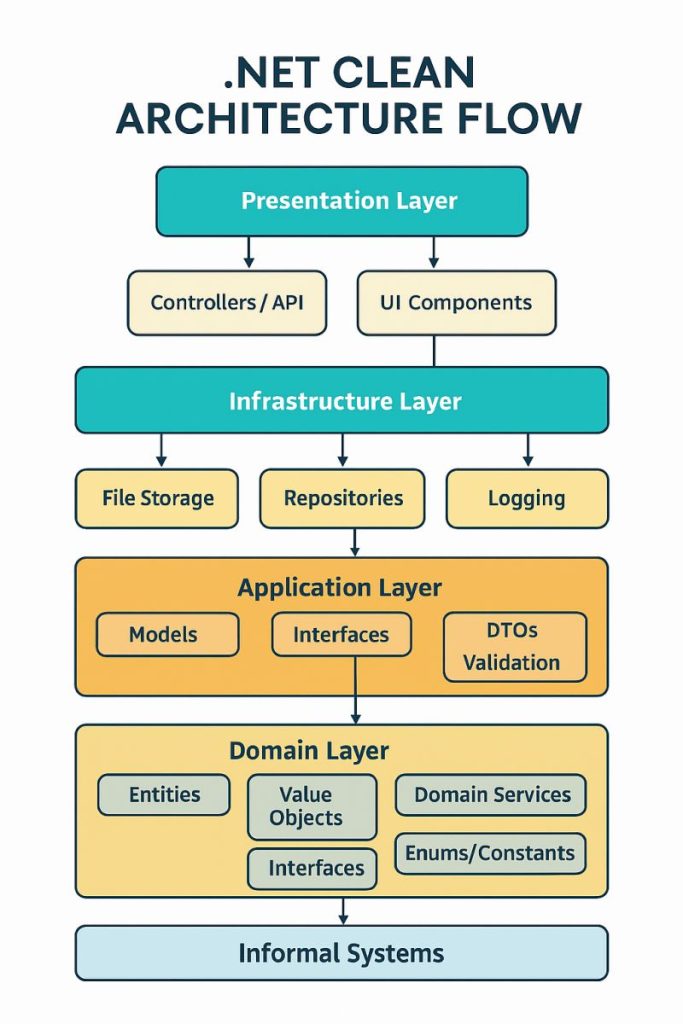
Building scalable, maintainable, and testable software is a constant challenge for developers. The .NET Clean Architecture pattern provides a clear and organized way to structure applications so that business logic remains independent of external concerns like databases, APIs, or UI frameworks.
The image above illustrates the flow of Clean Architecture in .NET, showing how different layers interact while maintaining separation of concerns.
🧩 1. Presentation Layer
This is the top layer where users or external systems interact with your application.
It includes:
- Controllers / APIs – Handle HTTP requests, process inputs, and return responses.
- UI Components – Represent the user interface, such as web pages or desktop forms.
This layer communicates with the Application Layer, sending user commands or data to execute business operations.
⚙️ 2. Infrastructure Layer
The Infrastructure Layer handles the actual implementation details that support the rest of the system. It’s where we integrate with the outside world — such as databases, file systems, or external APIs.
Common components include:
- File Storage – Managing files and directories.
- Repositories – Performing CRUD operations (Create, Read, Update, Delete) for data persistence.
- Logging – Capturing application events or errors.
In Clean Architecture, the infrastructure depends on the Application Layer, not the other way around. This ensures that your business rules never depend on technical details.
💼 3. Application Layer
The Application Layer coordinates the system’s behavior and defines what the application does — but not how it’s done.
It contains:
- Models – Represent application data structures.
- Interfaces – Define contracts that the infrastructure must fulfill (for example,
IRepository,IEmailService). - DTOs (Data Transfer Objects) – Simplify data exchange between layers.
- Validation – Ensures data integrity before passing information to deeper layers.
This layer acts as a mediator between the Presentation and Domain layers.
🧠 4. Domain Layer
The Domain Layer is the core of the system — where the real business logic lives. It’s completely independent of frameworks, databases, or UI.
It contains:
- Entities – Represent core business objects (like
Customer,Order,Product). - Value Objects – Immutable types that describe characteristics of entities (like
AddressorEmail). - Domain Services – Contain domain-specific operations that don’t naturally belong to a single entity.
- Interfaces, Enums, and Constants – Define reusable abstractions and values across the domain.
By keeping this layer isolated, you ensure that business rules remain consistent even if technologies or frameworks change.
🌐 5. Informal Systems
At the bottom, Informal Systems represent external dependencies like third-party APIs, external databases, or system integrations. The flow moves downward, but dependencies point inward — meaning the core domain never depends on external systems.
🔁 Why Use Clean Architecture?
- Testability – Business logic can be tested without infrastructure dependencies.
- Maintainability – Each layer can evolve independently.
- Flexibility – You can swap out databases, UIs, or external services without rewriting core logic.
- Separation of Concerns – Each layer has a clear and focused responsibility.
🚀 Conclusion
The .NET Clean Architecture Flow emphasizes a top-down communication and inward dependency rule — keeping your application organized, scalable, and easier to maintain over time.
By applying this structure, developers can focus on building robust business logic while ensuring the system stays adaptable to future changes in technology or design.